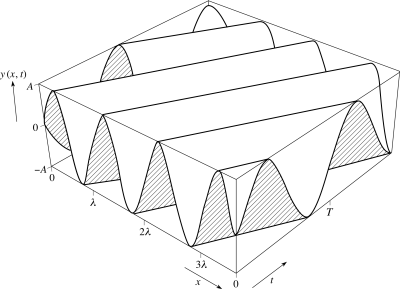Difference between revisions of "Wave mechanics"
| Line 56: | Line 56: | ||
where F and G are smooth functions. | where F and G are smooth functions. | ||
| + | |||
| + | We already know that y(x,t) = Ψ = Asin(kx - ωt) is a solution to the wave equation since this is the equation that we used to derive it. Thus there are many solutions but they all fit the form y(x,t) = F(x-vt) + G(x+vt). | ||
Revision as of 00:17, 27 May 2020
Contents
Introduction
Wave mechanics studies the properties of wave functions. These are periodic functions that carry information due to their periodic nature. The best way to study a function is to see how it changes, which can be done using derivatives, or derivatives of derivatives.
Basic Equation
The basic equation of wave mechanics is a function that describes the position of a particle as a function of time and displacement, where the function is wavelike, such as sine or cosine:
y(x,t) = Ψ = Asin(kx - ωt)
A = amplitude
k = 2π/λ where λ = wavelength
ω = 2πf = 2π/T where T = period
So if given the amplitude, wavelength and frequency of a particle that was behaving in a sine fashion, its position could be calculated at a particular time on the t axis using this equation. It would also give the particle position as a function of time at a particular distance on the x axis. Both plots y vs. x and y vs. t would be sine plots.
Partial Derivatives of basic wave equation
Use a table of derivatives to find the derivatives of the basic wave equation with respect to x and time.
∂y/∂x = Akcos(kx-ωt)
∂y/∂t = -Aωcos(kx-ωt)
Second Partial Derivatives of basic wave equation
Use a table of derivatives to find the second derivatives of the basic wave equation with respect to x and time.
∂2y/∂x2 = -k2Asin(ωt-kx)
∂2y/∂t2 = -ω2Asin(ωt-kx)
so 1/k2 ∂2y/∂x2 = 1/ω2 ∂2y/∂t2 since -2Asin(ωt-kx) is common to both
or 1/k2 ∂2y/∂x2 - 1/ω2 ∂2y/∂t2 = 0
Wave Equation in One Dimension
since the speed of a wave (v) is equal to ω/k, the above equation can be expressed in terms of wave velocity by multiplying by ω2:
v2 ∂2y/∂x2 - ∂2y/∂t2 = 0
or:
v2 ∂2y/∂x2 = ∂2y/∂t2
which is the general wave equation in one dimension that is used to describe situations involving periodic behavior.
Solutions to Wave Equation in One Dimension
using fourier transform:
- multiply both sides by e-ikx
- integrate with respect to x
eventually end up with:
y(x,t) = F(x-vt) + G(x+vt)
where F and G are smooth functions.
We already know that y(x,t) = Ψ = Asin(kx - ωt) is a solution to the wave equation since this is the equation that we used to derive it. Thus there are many solutions but they all fit the form y(x,t) = F(x-vt) + G(x+vt).
